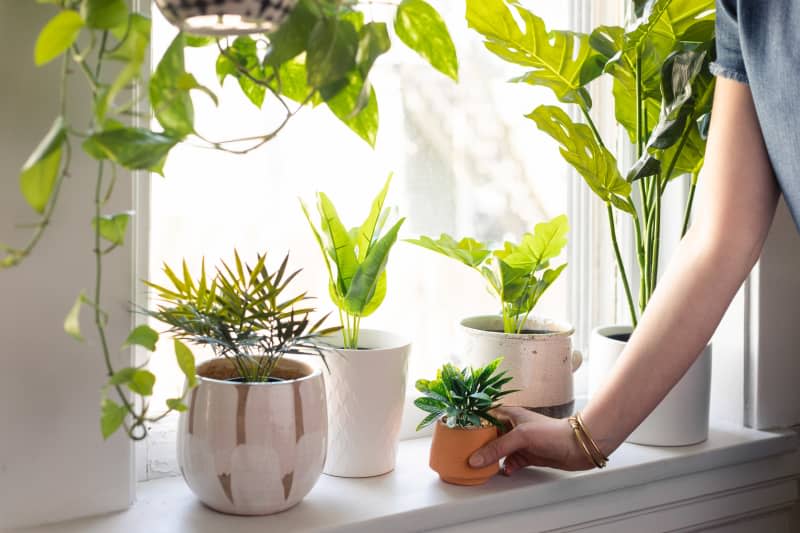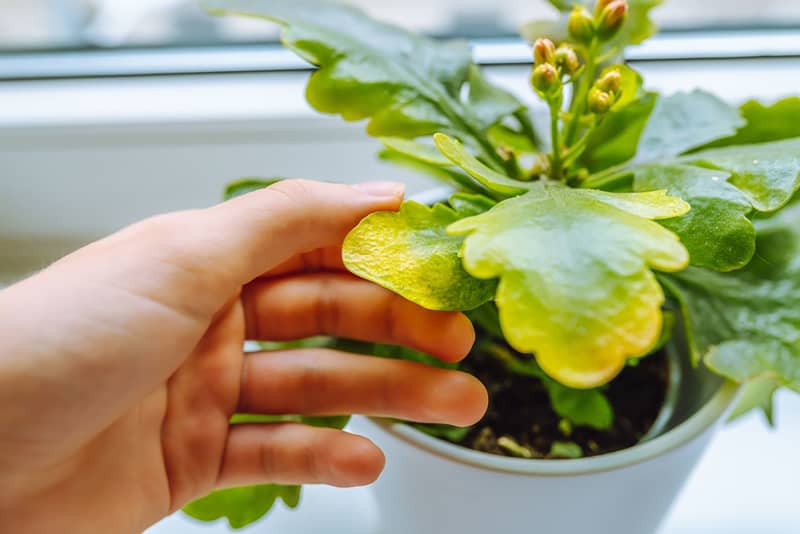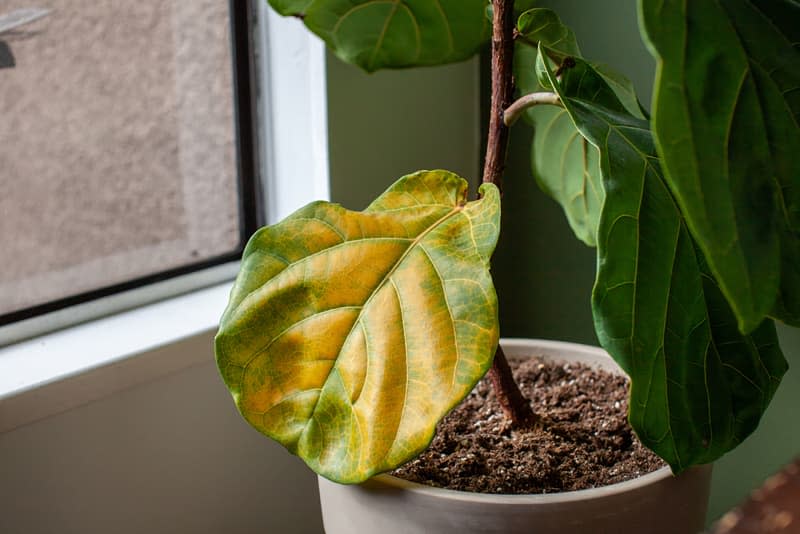6 Reasons Your Plant Has Yellow Leaves, According to Pros

If you’ve ever been a concerned plant owner, you probably know that yellowing leaves are one of the first signs that something isn’t quite right with your plant. But there are a lot of different reasons your plant’s leaves might turn yellow, from not enough water to too much sun to icky houseplant pest problems. And a sick plant might not always have time to wait out lots of trial-and-error.
“I’ve always thought of yellow leaves on houseplants like the upset stomach of the plant world,” says Justin Hancock, a horticulturist at Costa Farms, because that one general symptom could have any number of causes. So what can you, as a plant owner, do? Although there is no one-size-fits-all reason for your yellowing plants, here is expert advice on how to diagnose and help your plant if you notice leaves that are turning yellow.
Your plant has moisture stress.
If you notice your plant’s leaves turning yellow, get ready to play plant therapist and check for signs of stress. The most common plant stressor is too much or too little water, which is absorbed through the roots and released through the leaves.
“When there’s too much moisture in the soil, plant roots can’t breathe properly,” says Hancock. The unfortunate result is that plants can suffocate and die if they are overwatered, and the first sign of this is leaves turning yellow as the plant tries to conserve its root system.
Leaves can also turn yellow if the potting mix is too dry, causing the plant not to get any water at all. “In this case, there’s not enough moisture in the potting mix for the roots to pull up into the plant,” says Hancock.
Watering is a delicate balance, so always consult the instructions for your particular plant. Proper drainage is also essential to maintain this balance and allow excess moisture to escape. “Houseplants without proper drainage can develop root issues like root rot,” adds Jessica Mercer, PhD, of Plant Addicts. Yellow leaves can be an indicator of root rot, which is more likely if your plant lives in a pot with no drainage holes.
Your plant needs more — or less — sun.
Another likely reason your plant’s leaves turn yellow is that they’re starved for sunshine. If your apartment doesn’t get a lot of natural light, it may be time to book your plant’s next sunbathing session. However, according to Hancock, yellow leaves can also indicate an overabundance of sunshine.
“Like people, plants can get sunburn,” he says. “Sunburn can occur when a plant gets more sun than it can handle or is acclimated to.” To let a new plant adjust to sunlight, Hancock advises slowly moving your plant closer and closer to a light source to build up tolerance, if necessary.
For a plant that needs more sun, consider relocating it permanently to a sunny spot or at least giving it a sun spa day (letting it soak up the sun near a window for a few hours). Watch the plant carefully to see how it deals with the big move, as some sensitive plants can have difficulty adjusting after a relocation.
It may sound obvious, but if your window has blackout curtains, make sure that you’re leaving them open for enough hours to make nearby plants happy. Remember that even if you’re not home to enjoy the sunshine during the day, your plant is.
Your plant is overcrowded.
If it’s been a while since you repotted your houseplant, you may need to place it in a larger pot or divide the plant.
“Roots outgrow the confines of the container,” says Mercer. When roots become crowded, they start to encircle the perimeter of the pot, leading plants to become “root bound.” A root-bound plant has tightly constricted roots and can’t absorb water and nutrients as easily, leading to yellow leaves.
If left too long, the expansion of roots can also crack pots due to pressure.
Mercer advises looking for roots growing out of drainage holes or poking over the side of the plant to determine if its roots are bound. Sometimes, root-bound plants easily pop out of their containers. If you want to take a peek at the roots, carefully lift the plant out of its pot before examining.

Your plant has a fungus or pest.
Another issue you should consider is disease, as both fungal and bacterial diseases can cause leaves to turn yellow as the plant is attacked.
“Often, diseases start at yellow spotting or black or brown spots accompanied by yellowing of the leaf,” says Hancock. He recommends treating your plant with a houseplant-safe fungicide to stop the spread.
It’s also important to treat your plant carefully while applying a fungicide so your plant can simply concentrate on getting well. Proper water and sunlight in a draft-free area are a must.
A pest infestation could be also to blame for yellowing leaves. Although difficult to see with the naked eye, mealybugs or spider mites may be harming your plant. If pests are present, you’ll likely notice other signs of an invasion upon close inspection. Here are some common houseplant pests to be on the lookout for:
Mealybugs
Are there tiny holes on the leaves? This may indicate that spider mites are chomping on them. Do you spot a fluffy white wax on your plant? Mealybugs may be the culprit.
To quell infestations, try rinsing off your plant, pruning the affected, wilting leaves, and then spritzing the plant with store-bought insecticidal spray or treating plants with neem oil.
Your plant needs fertilizer.
You may assume that your plant is getting all the nutrients it needs from the soil, yellowing leaves may indicate that a nutrient deficiency is interfering with photosynthesis.
If your plant’s older leaves are turning yellow and the new ones are very light green, this could be caused by a nitrogen deficiency. Look for houseplant-specific fertilizer that features nitrogen.
Make sure to follow the instructions and the recommended feeding rate to avoid fertilizer burn, which can cause leaves to brown. With just the right amount of fuel, your plant will look lush again in no time.

Your plant is aging.
Just like humans get gray hair and show other signs of getting older, some plants can do the same.
Mercer says that sometimes aging leaves are simply part of the aging process for plants. “Older leaves may turn yellow, then brown, and finally fall from the plant,” she says.
Hancock also agrees and says a yellow leaf here and there is probably nothing to worry about. However, if new growth or an overabundance of leaves turn, it’s time to be concerned. “If you see a bunch of leaves go yellow at one time or the yellowing tends to happen at the top of the plant, then it’s something to pay attention to,” he recommends.

